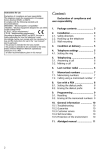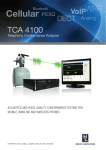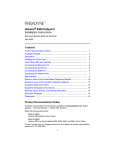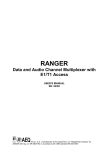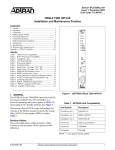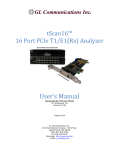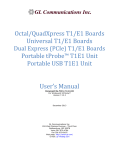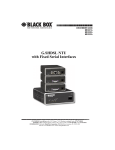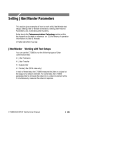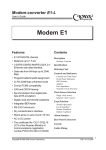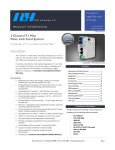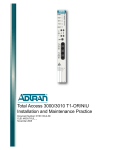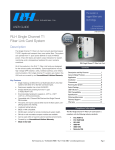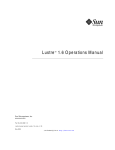Download TCA 8200 brochure screen res.pub
Transcript
TCA 8200 Telecom Conformance Analyzer One – box approvals solution for Analog PSTN, Acoustic, xDSL, VoIP, T1, E1 and ISDN PRI interfaces Key standards • TS103 021, TBR 21, EG 201 121 • TBR 4, 12, 13 • EN 301 437,TBR 37, 38 (Europe) • FCC Part 68, TIA-968-A (USA) • CS-03 (Canada) • S002, S003, S004, S016 (Aus) • JATE (Japan) • ITU-T G.703, G.823, G.824 • ETSI TS 102 027-1, 2 (SIP) • ITU-T P.862 (PESQ VQT) Applications • Compliance testing • Pre-compliance testing • Development testing • Production testing TCA 8200 Compliance testing to world’s major standards TCA 8200 provides compliance testing solution according to the world’s major network access standards, covering many types of telecom equipment ranging from handset telephones to digital switches, PBXs and VoIP gateways. In the past, approval of terminal equipment meant using a test lab with expert test engineers and tens of non-automated or semi-automated expensive test instruments and setups. Such process usually took weeks. With TCA 8200 you can complete the tests and the documentation required by the standards and agencies in a matter of hours without a need for in-depth knowledge of the standards. Due to recent liberalization of regulation processes in Europe, the USA and other countries manufacturers can now perform in-house testing and declare compliance or apply for approval of a regulatory agency. Having an in-house compliance testing solution from early design stages can significantly reduce time-to-market. Test labs can benefit also from the ability to provide fast and cost-effective testing services for a broad range of the interfaces and standards covered by the instrument, its expandability and its extensive management features. Fully automated testing TCA 8200 comes with test suites ready for testing according to the supported standards. The tests can be performed in a fully automatic manner one by one or in a sequence. No user interaction is required except for setting of the equipment under test in response to prompts appearing on the screen. 1 HERMON LABORATORIES Test project Test run Test report Completely unattended testing is possible for equipment that can be remotely controlled with ASCII commands. Any user-defined commands or built-in AT commands can be used for automatic remote control of the equipment over RS-232 or TCP/IP Ethernet. Such functionality together with the capability to define custom tests and test sequences is especially useful for production testing. Reports in MS Word format with test results and all the information required for a test project are generated automatically. Deciding what standard’s tests are applicable for a particular product can be sometimes a complicated task. Predefined and user-defined criteria for selection of the required tests simplify this task. The tests are automatically selected by answering Yes/ No questions about the functionality supported by the product. The tests can also be selected manually. A test can be automatically repeated with different (or the same) sets of test parameters and limits. TCA 8200 Powerful Display and Analysis features Test results are displayed continuously on graphs and table, together with current test status and verdict, key test parameters, user prompts, current test point and measured values. Time and frequency domain measurements with minimum, maximum and average statistics are provided. In each test, you can set which results will appear on the display and in the test report, set limits, number of plots per graph, style and color of each plot, select Log or Linear axis, set axis scale or select auto-scaling, select which test parameters will appear in the test report, rename test results, add comments and environment conditions description to test results. Measured results can be analyzed by using markers, delta markers, zoom in/ out, max/min peak search, scroll and pan graph features. Further analysis is possible by copy/pasting the results to the preinstalled MS Excel. Manual operation Besides fully automated testing capability, TCA 8200 provides onthe-fly control of test parameters, “manual” tuning and stepping, which is important for development and debugging testing. Test execution can be paused/resumed, automatically swept or manually stepped through multiple test ranges. Also a test can be run once or continuously, at multiple test points or at a single test point (e.g. frequency). 2 1. Setting results format Lab in a box TCA 8200 is not just a test instrument. It is also a highly integrated system of tools and features for performing and supporting tasks required in a test lab such as: • Definition and management of test specs and test plans with customized user prompts, remote EUT control commands, and automatic tests selection criteria. • Running and management of test projects. • Integral client information database linked to test projects. • Generation and management of test reports. • Built-in calibration tests. • Backup and restore of all data and restore of the factory data. • Emergency recovery of all software and factory data from image disk supplied with the system. • Quality assurance issues have been thoroughly addressed: Test reports are ISO/IEC 17025 compatible. Tests, test suites, projects, reports are uniquely identified. Changes to test definitions are recorded. 2. Setting limits Versatility and ease of use TCA 8200 features familiar Windows user interface. Test suites, test projects, tests, reports and other data and tools are presented in Windows Explorer-like tree/list views. Intuitive Open, New, Delete, Save, Properties data operations are implemented through double-click, menus, toolbar icons, and right mouse button context-sensitive pop-up menus. 3. Setting test ranges In addition to built-in tests, users can easily create new custom tests by setting results format, test parameters, ranges, limits, EUT remote control commands, user prompts and test execution sequence. No programming or scripting is required. Both system and user tests are grouped in test suites. New test suites for new standards or for user specifications can be created. Test suites are used to access, set and run tests, and serve as templates for new suites and projects. Project provides tools to run and manage tests, store and document test results. Project is created from one or multiple test suites, inheriting all their definitions. It contains all the information required for a test project: • Details of the product under test. Client details. Project performance information. • Test specification - group of tests with test definition, created from one or more test suites. You can modify the test specification in the project. You can also save the project test specification as a test suite, so it can be used as a template in other projects and suites. • • Project and tests status and verdict. 4. Setting test parameters Test results are saved for each test execution in the project. You can select which results will be included in the test report. You can generate test reports in MS Word format for each test suite included in the project. You can open, print and delete test reports from the project. You can include MS Word documents in a test suite or in a project to document unsupported tests or to include additional information in a test report. TCA 8200 3 On-line help and support TCA 8200 features a comprehensive context-sensitive online help with examples and step-bystep guidance. The tests are thoroughly documented with EUT connection and configuration instructions, test specification and measurement uncertainty data. The TCA 8200 user interface accommodates both novice and advanced user’s needs. Step-by-step wizards are provided together with straightforward shortcut operations. Remote configuration, user guidance and training can be provided over internet through remote operation of the TCA 8200. Interoperability TCA 8200 includes all common PC interfaces: USB, parallel, RS-232 and Ethernet, which allows test reports and results printing to any Windows compatible local or network printer. Test reports and backups can be stored on the internal hard disk, external or network drive. TCA 8200 can be transparently operated from a remote PC over LAN and internet by using the Windows Remote Assistance feature. Low cost of ownership TCA 8200 comes with a price significantly lower than the total cost of equipment and systems it can replace such as a digital oscilloscope, spectrum and network analyzers, digital transmission and jitter analyzer, line and cable simulators, power supplies, protocol, frame, signaling analyzers, various test bridges and a PC. Achieving automation requires further investment in integration and software development or buying expensive third-party solutions. be upgraded later for any additional options. Testing capabilities can be easily extended to cover new standards by defining new user test suites using the GUI or obtaining updates from Hermon Laboratories. Analog PSTN interface testing The Analog PSTN tests cover the requirements for terminal (CE) and network (CO) equipment including electrical AC, DC and timing characteristics in on-hook, off-hook states and during the transition between those states, various functional and simulation tests. CO, CE, and line simulation Extensive analog PSTN network simulation features found in standalone line simulators coupled with line states and dialed number recording provide an invaluable tool for functional tests. Different CO’s and networks can be simulated by predefined and userset call progress scenarios with programmable conditions, valid/ invalid numbers definition, delays, dialing timeouts, connection to second auxiliary channel, progress tones and ring signals. A database of predefined progress tones and ring signals used in different countries is provided. Acoustic testing Acoustic tests are required to verify that speech performance of handset telephones is adequate to ensure compatibility with the PSTN and other telephones. The speech performance is assessed by measuring transmission characteristics at various combinations of transmission paths: Sound pressure is applied to the telephone handset microphone and measured at the speaker. Stimulus signals are applied and measurements are performed at the telephone line interface with various loop simulation characteristics. The handset is placed in a test head which provides the reference standard positions from the built-in ear and mouth simulators. The ear and mouth simulators are connected to the TCA 8200 via input preamplifier and output power amplifier. The receiving and sending sensitivity, noise, distortion, loudness, linearity, instability, echo return loss and side tone tests are performed according to procedures and specifications defined in ITU-T P.64, P.79 and ETSI TBR 38. Digital T1 and E1 interfaces testing The digital tests cover layer 1 electrical characteristics of input and output ports, digital, combined analog and digital transmission and functional characteristics of framed and unframed T1 and E1 interfaces. In addition to test results shown on graphs and table, line monitor indicators display current error and alarm status of the TCA T1 or E1 receiver. Acoustic Test Setup Due to the instrument’s modular design you can order and pay for the test options that you need. You can order separately Analog PSTN, E1, T1, Analog PSTN + DSL, Analog PSTN + Acoustics or E1 + ISDN PRI test options. The instrument can TCA 8200 4 Jitter measurement tests feature amplitude auto-ranging and display of the measured jitter modulation waveform versus time. Pulse shape tests provide simultaneous measurements of all positive and negative pulses, and space characteristics with automatic mask fittings and scaling, and user-defined masks. Frame analysis tests provide the most powerful features for simulation and analysis of 2.048 Mbps CCS & CRC structure. In the heart of the frame analysis tests lies the Test Procedure definition which contains a sequence of Pulse Shape measurement test cases. Each test case includes a userdefined transmit data pattern of variable length and the expected receive events criteria. Predefined error, alarm or data patterns are provided. You can also set any bit in framing and each data timeslot. You can define a series of expected receive events such as CRC error, frame error, RAI, FEBE and AIS conditions with start time, duration repetitions limits for each event. When a frame analysis test is run the test cases sequence is executed. The data patterns are transmitted; the received events are recorded with single frame resolution and compared to the expected events criteria with automatic verdict setting. Predefined frame analysis tests such as TBR 4 9.4 Frame structure and 9.5 Operational functions tests are provided. CAS simulation and analysis coupled with built-in database of signals and signaling states provide powerful testing capability of virtually any E1/T1 CAS protocol. The L23 option provides full layer 2 and 3 testing of 2.048 Mbps ISDN PRI in accordance with TBR 4. The tests include a user-defined series of TTCN test cases defined in TBR 4. TTCN is a programming–like language that describes protocol simulation, analysis, and verdict criteria test procedure. When the layer 2 or 3 tests are run the test cases are executed one-by-one with automatically-set verdicts and recording of transmit and receive layer 2, 3 messages. Frame Analysis test case definition Jitter measurement TCA 8200 5 2.048 Mbps interface (opt. E1) Specifications Supported standards1,6 Analog PSTN 2 / 4-wire TE and CO (opt. ALG) ETSI TS 103 021, TBR 21, EG 201 121 (Europe) 2 FCC Part 68 , TIA-968-A (USA) CS-03 Part I (Canada) AS/ACIF S002, S003 (Australia) JATE, Analog Terminals (Japan) IDA TS PSTN 1 (Singapore) HKTA 2011, 2013 (Hong Kong) MoC 023/96 (Israel) Decree No. 322 (Brazil) ITU-T O.9, O.81, G.712, Q.551, Q.552, Q.553 2 3 4 5 FCC Part 68, TIA-968-A (USA) (ADSL) T1.TRQ.6-2001 (USA xDSL) CS-03 Part VIII (Canada xDSL) AS/ACIF S043.2 (Australia xDSL) 4 ETSI TS 101 388 (ADSL) ITU G.991.2 (SHDSL) 4 4 4 ETSI TS 101 270-1 1 (VDSL) 4 1.544 Mbps interface (opt. T1) FCC Part 68, TIA-968-A (USA) CS-03, Part II (Canada) JATE, Digital Terminals (Japan) HKTA 2017, 2018, 2028 (Hong Kong) ITU-T G.703, G.704 ITU-T G.824 ITU-T O.9, O.81, G.712, Q.551, Q.552, Q.553 TCA 8200 - Excluding: Magnetic field HAC test - opt. L23 is required for Layer 2 and 3 testing - See xDSL electrical characteristics and transmit power below, for 6 - Requires third-party base station transceiver equipment - Contact Hermon Laboratories for other available standards Main tests Analog PSTN xDSL: ADSL, HDSL, HDSL2, HDSL4, SHDSL, SDSL, VDSL CPE and CO (opt. DSL) ITU-T G.992.2 (G.LITE ADSL) - Excluding: High voltage (surges, overvoltage protection, leakage current), EMC, safety, environmental tests supported tests 5 EN 301 437 (former TBR 37) , TBR-38 (Europe) FCC Part 68 AS/ACIF S004 (Australia) ITU-T P.340, P.313 TIA/EIA – 470 ITU-T G.992.1 (ADSL) 3 ISDN PRI: TBR 4 (Europe) – Layers 1, 2, 3 AS/ACIF S003, S016 (Australia) JATE, Digital Terminals (Japan) NOM – 152 (Mexico) ITU-T G.703, G.704 ITU-T G.823 ITU-T O.9, O.81, G.712, Q.551, Q.552, Q.553 1 Acoustics and Telephonometry testing of handset and hands-free telephones (opt. ACU) ETSI/3GPP TS 151 010-1 (Digital cellular phones) TBR 12 (Europe) TBR 13 (Europe) Automatic dialing Automatically repeated call attempts Clearing of automatic calls DC characteristics in on-hook and off-hook states: Voltage vs current, resistance vs current, DC current DC Resistance DTMF, MF, MFC Signaling Received digits, digit waveform vs time / frequency, low & high group voltage / power / frequency, twist, tone / pause / cycle duration with statistics, noise, rise & fall time DTMF, MF, MFC digits generation with programmable frequency, level and duration Hazardous voltage limitations Impedance in on-hook and off-hook states Impedance - IZI, Phase, Resistance, Reactance, Inductance, Capacitance, Return loss Impulse noise Insertion loss (Series TE) Intentional operational paths to ground Intentional protective paths to ground Line liberation through power failure Longitudinal conversion loss Loop current characteristics Loop interruption tolerance Output signal balance Progress tone detection and generation with programmable level, frequency, duration, cadence and timing Pulse signaling Received digits, voltage/current vs time and voltage vs current plots, make/break levels and duration, resistance, inter-digit pause, pulse ratio – statistics Pulse digits generation with programmable duration and N / N+1 encoding Relative frequency response R.E.N determination Return loss Ring detection and generation with programmable level, frequency, duration, cadence and timing 6 Ringing impedance Ringing signal overload Series DC Resistance (Series TE) Signaling interference Spectrum Analysis Signal and Noise level measurements vs time and frequency Instantaneous, mean, RMS voltage and power – broadband and narrowband with various BW and filters, psophometric noise, impulsive noise - statistics TIMS and Through Transmission – Narrowband and Broadband tests (see 1.544 Mbps and 2.048 Mbps TIMS and PCM tests) Through Transmission – SF cuttoff Transient after change to the opposite polarity Transient response Transmission delay Line, CO and TE simulation Variable DC loop feed voltage and current limit Variable series resistance, complex line length and terminations Call simulation and analysis of FXS, FXO loop-start, DID and ground-start interfaces including: Generation, detection and measurements of DTMF, MF, MFC signals and numbers with variable levels, frequency, duration and timing Pulse signaling with variable duration and N / N+1 encoding Progress tones (dial, progress, busy, ringing tones, etc) and Rings with variable level, frequency, cadence and timing Off-hook, on-hook, wink, flash, polarity reversal and ground-start states with variable characteristics Playback and recording of .wav files Programmable received event masks and if / then / goto conditions for flow control of the simulation execution and verdict setting Programmable user messages, user verdicts and remote commands (for EUT automatic operation) Pre-defined and user defined database of signals and encodings Acoustics and Telephonometry Acoustic shock Receive Loudness Rating (ROLR, RLR) Receive Volume Control and Hearing Aid Compatibility Sending and Receiving Sensitivity frequency response Sending and Receiving Sensitivity Sending and Receiving Loudness Sending and Receiving Linearity Sending and Receiving Distortion Sending and Receiving Noise Sidetone and STMR Spectrum analysis with acoustic stimulus Sound Pressure Level (SPL) and SPL volume units Instability and Howling Echo return loss xDSL electrical characteristics and transmit power Power spectral density Aggregate total signal power Spectrum Analysis Longitudinal output voltage Transverse balance Longitudinal conversion loss Return loss Intentional operational paths to ground Intentional protective paths to ground On-hook resistance TCA 8200 DC current during ringing Ringing frequency impedance 1.544 Mbps and 2.048 Mbps interfaces Layer 1 (Physical layer) Clock accuracy measurements Return loss Transverse balance Impedance towards ground Tolerable longitudinal voltage Receiver sensitivity Bit Error Rate tests (BERT) Pattern, line code, frame error and error rate; CRC error (2.048 Mbps), errored superframes (1.544 Mbps) RAI and REBE alarm measurements (2.048 Mbps); LOS, LOF, AIS detection; pattern and line code error insertion. Immunity to attenuation and reflections Simulation Transmitter carrier level attenuation Cable simulator attenuation Interfering signal with 18 dB attenuation mixed with the carrier Error and alarm measurements 3.3V / 2.7V 0 / 6 / 12 dB on/off As in BERT Jitter Jitter generation and measurement, jitter transfer, jitter tolerance, maximum tolerable jitter, wander generation complying or exceeding O.171, G.823, TBR 4, 12, 13 • Jitter measurement and generation on data and clock • Jitter Measurements: UIpp and UIrms jitter level with statistics Demodulated jitter vs time waveform Low-pass and high-pass filters with continuously variable cutoff frequency • Error and alarm measurements • Transmitter clock frequency offset Pulse shape Simultaneous positive, negative pulses and space measurements with automatic mask fitting, with pulse width and pulse amplitude ratio measurements with averaging and statistics. User-defined masks. Output power and voltage With time, spectrum and harmonic analysis TIMS and PCM analysis Two-channel A-A, A-D, D-A, D-D narrowband and broadband through transmission tests Stimulus/Measurement channels: • (A) Analog channel A/B with DC loop feed simulation (in/out/off) – opt. ALG required • (D) Encoded/decoded into any PCM timeslot of 2.048 Mbps or 1.544 Mbps interface Tx/Rx port. TIMS and PCM analysis tests include: Gain, Loss, Level, Variation of gain with frequency, Variation of gain with level, Idle channel noise, Crosstalk, Harmonic distortion, THD, Intermodulation distortion, SINAD, SNR, Noise, Spurious (in-band and out-of-band), Group delay, LCTL, TCTL, TBRL, SF cutoff, SF guard band. Frame analysis Simulation and analysis of any error, alarm and normal operation events of 2.048 Mbps CCS & CRC structure. Simulation: TBR 4 defined or user-set stimuli with up to single bit resolution, inserted into any transmit framing and data timeslots. Analysis: Automatic verdict setting according to programmable expected events criteria with time limits. 7 Event recording with time, frame and multi-frame stamp, and single frame resolution. CAS Signaling analysis Call simulation and analysis of various CAS protocols: ABCD bits signaling simulation and analysis Encoded DTMF, MF, MFC signals and numbers with variable levels, frequency, duration and timing Encoded progress tones (dial, progress, busy, ringing tones, etc) and Rings with variable level, frequency, cadence and timing Off-hook, on-hook, wink, and other states with variable characteristics Playback and recording of .wav files Programmable received event masks and if / then / goto conditions for flow control of the simulation execution and verdict setting Programmable user messages, user verdicts and remote commands (for EUT automatic operation) Pre-defined and user defined database of signals and encodings Layer 2 and 3 protocol analysis for 2.048 Mbps ISDN PRI Layer 2 and Layer 3 TTCN conformance testing according to TBR 4 standard for 2.048 Mbps ISDN PRI with user-set PICS/PIXIT parameters and recording of Tx and Rx layer 2, 3 messages in text and binary format Voice Quality Testing (opt. VQT) PESQ (Perceptual Evaluation of Speech Quality) through transmission testing of a combination of the following TCA transmit – receive ports: analog (FXS or FXO), acoustic (mouth or ear simulator), 2.048 Mbps (A-law encoded in a payload timeslot), 1.544 Mbps (u-law encoded in a timeslot) with on-line analysis and recording to . wav file(s) Off-line analysis of degraded vs reference .wav files Including the following measurements: PESQ MOS per ITU-T P.862 and MOS LQO per ITU-T P.862.1 Delay and delay jitter Reference and degraded signal level and loudness with aligned and non-aligned waveforms R factor (ITU-T G.107 e-model) VAD (Voice Activity Detection) performance analysis: Front End Clipping, Hold Over Time (Hang Over Time) Speech dropout Test Interfaces (front panel) 1544 kbits/s interface (opt. T1) Tx and Rx connectors 3-pole Bantam jack, 100 Ω, balanced Line Coding Framing Format B8ZS, AMI ESF (193E), D4 (193S), Unframed Clock Input / Output (opt. E1 or T1) Input / Output 1.544 MHz or 2.048 MHz TTL signal, depending on test configuration Connectors BNC female, unbalanced 2048 kbits/s interface (opt. E1) Tx and Rx connectors 3–pin Siemens jack, 120 Ω, balanced BNC female, 75 Ω, unbalanced Line Coding Framing Format HDB3, AMI CCS & CRC4, CAS & CRC4, CCS, CAS, Unframed ISDN PRI Layer 2 and Layer 3 testing according to ETSI TBR 4 (opt. L23) Protocol Testing SIP protocol conformance testing (opt. SIP) Conformance testing of SIP - Session Initiation Protocol (defined in RFC 3261) over 10 / 100 Base-T ethernet interface per ETSI TS 102 027-1 V1.1.1 (2002-08), ETSI TS 102 027-2 V2.1.1 (2003-10) SMS and CID testing (opt. SMS) SMS and CID protocol testing over analog interfaces per ETSI EN 300 659-1 V1.3.1, ETSI EN 300 659-2 V1.3.1, ETSI EN 300 659-3 V1.3.1, ETSI ES 201 912 V1.1.1 ETS 300 648, ETSI EN 300 778-1,2 V1.2.1 TCA 8200 8 Analog PSTN interface (opt. ALG) Two Analog 2-wire test ports with loop simulation and programmable ring and progress tone generator (CH A, CH B), External termination (Zref) input, External series (feed) resistance input, Speaker for audio monitoring with volume control (CH A only), Off-hook LED indicator Connectors 3–pin Siemens jack Loop simulation DC power supply Loop feed channel Output Voltage Current Limit Voltage resolution Voltage accuracy Polarity switching time DC resistance test channel Output voltage Maximum current Voltage resolution Voltage accuracy Series resistance Range Resolution Terminations (Zref) Artificial line network SVGA output Connects to external monitor supplied with the system Connector type HD15 female USB USB 1.0 compatible Connector type 0 - 110 Vdc 0 - 200 mA 30 mV 200 mV < 0.2 ms 0 - 500 Vdc 10 mA 0.2 V 0.4 V 0 - 300 kohm or external 5 ohm or 10 ohm depending on test configuration Variable according to the supported standards, external or software simulated R1 + (R2 II C2) for measured impedance calculation Variable according to the supported standards Ring generator RS-232 Connector type DB9 male Parallel Connector type DB25 female Ethernet 10/100 Mbit/s NIC Connector type RJ-45 female Keyboard Connects to external keyboard supplied with the system Connector type PS/2 female Mouse Connects to external mouse supplied with the system Connector type PS/2 female Built-in PC Pentium III processor 256 MB RAM Internal 20 GB minimum hard disk Internal 3.5” 1.44 MB floppy disk drive Display External 15” TFT color monitor, 1024 x 768 resolution, supplied with the system External keyboard and mouse 0.2 V 0.5 V Progress tone generator Programmable frequency, level, on/off duration, cadence Acoustic interface (opt. ACU) Audio frequency generator output (BNC female) and measurement input (LEMO type) ports connected to the external setup which includes a test head for handset fixation with mouse and ear simulators xDSL interface (opt. DSL) Testing xDSL electrical characteristics and transmit power provided through Analog PSTN and 1544 kbit/s interfaces. Supplied with the system General Power requirements 90 – 132 V AC rms, 57 Hz – 63 Hz, 5 A maximum (@ 90 V) 180 – 264 V AC rms, 47 Hz – 53 Hz, 3 A maximum (@ 180 V) with all options installed and including the external monitor Environmental Conditions Temperature Operating: Storage: 5° C to 45° C -10° C to 60° C Relative Humidity Operating: 30% to 80% Storage: 10% to 85% Altitude Operating: Storage: TCA 8200 Single port type A female Serial Programmable frequency, level, on/off duration, cadence Output voltage 0 - 150 Vrms Output power 22.5 W maximum Frequency 10 - 100 Hz Voltage resolution Voltage accuracy Rear panel interfaces up to 10,000 feet (3,048 meters) up to 31,500 feet (9,600 meters) 9 Regulatory Compliance EMC EN 61326 FCC Part 15, Class A Safety EN 61010-1 Dimensions 455 mm (W) x 325 mm (H) x 690 mm (D) without 19” brackets, external monitor, keyboard, mouse, external acoustic option accessories. Weight 50 kg with all the options installed without 19” brackets, external monitor, keyboard, mouse, and external acoustic option accessories. Ordering information TCA 8200 Telecom Conformance Analyzer Includes instrument mainframe with internal HD and FDD, operating software, MS Windows XP Professional OS, MS Office SBE factory installed, external 15” LCD TFT color monitor, keyboard, mouse, media containing backup of all software and data and on-line User Manual At least one of the following options must be ordered. Opt. ALG Opt. ACU Analog PSTN interface testing. Acoustics and telephonometry testing of handset telephones. Includes external power amplifier, preamplifier, ear simulator, mouth simulator, test stand for handset. Opt. DSL Opt. E1 Testing of xDSL electrical characteristics and transmit power. 2048 kbit/s interface Layer 1 testing. Opt. T1 Opt. L23 Opt. VQT Opt. SIP 1544 kbit/s interface Layer 1 testing. ETSI TBR 4 Layer 2 and Layer 3 ISDN PRI testing. PESQ voice quality testing. SIP protocol testing over 10 / 100 Base-T Ethernet interface. Opt. SMS SMS and CID testing over analog PSTN interfaces. Option ACU requires option ALG. Option DSL requires option ALG. Option L23 requires option E1. Option SMS requires option ALG. Option VQT requires at least one of the ALG, ACU, T1 or E1 options. All the options except for options L23, VQT, SIP and SMS must be factory installed. All the options can be installed together. Recommended accessories External USB CD-RW For backup/restore and emergency software and factory data recovery. Copyright 2003-2004 Hermon Laboratories Ltd. All rights reserved. Specifications are subject to change without notice. Product and company names are trademarks of their respective owners. HERMON LABORATORIES HaTachana st. P.O.Box 23, Binyamina 30550 Israel Tel. +972-4-6288001 Fax +972-4-6288277 Email: [email protected] Web: www.hermonlabs.com TCA 8200 10










